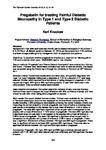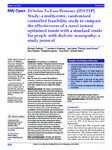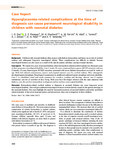Pregabalin for treating Painful Diabetic Neuropathy in Type 1 and Type 2 Diabetic Patients
| dc.contributor.author | Kruckow, K. | |
| dc.date.accessioned | 2019-05-15T10:16:01Z | |
| dc.date.available | 2019-05-15T10:16:01Z | |
| dc.date.issued | 2012 | |
| dc.identifier.citation |
Kruckow, K. (2012) 'Pregabalin for treating Painful Diabetic Neuropathy in Type 1 and Type 2 Diabetic Patients', The Plymouth Student Scientist, 5(1), p. 61-78. | en_US |
| dc.identifier.issn | 1754-2383 | |
| dc.identifier.uri | http://hdl.handle.net/10026.1/13966 | |
| dc.description.abstract |
Background: It has been estimated that chronic painful diabetic neuropathy (PDN) affects 1 in 6 (16.2%) of all diabetic patients (Diabetes UK, 2010) yet the symptoms of PDN continue to present a huge challenge in its management both for physicians and patients. Objectives: To ascertain whether pregabalin is effective as a treatment for relieving pain in PDN and to identify which dose: 150/300/600 mg/d is most effective. Search methods: ";Pregabalin"; and ";Painful Diabetic Neuropathy"; were entered into Pubmed and Scirus. ";Humans"; and ";randomised controlled trial"; were entered as limiters. The search was completed using the Athens log in through the University of Plymouth on 28th February 2011. Selection criteria: Randomised double-blind controlled trials, with patients diagnosed with Type 1 or Type 2 diabetes mellitus and a diagnosis of PDN for a duration of ≥1 year were selected. Studies which reported the effectiveness of taking dosages of pregabalin of 150 mg per day (mg/d), 300 mg/d or 600 mg/d and a placebo for pain relief were used in this meta-analysis. Only completed studies were included. Data collection and analysis: The author used strict inclusion criteria to extract the data. Revman 5 was used to analyse the mean difference with 95% confidence intervals and fixed effects for pain relief when taking either pregabalin or placebo. Main results: The search yielded fourteen studies. Thirteen were available via the University of Plymouth subscription and one was requested via the inter-library loans service. Six studies including 1,628 participants were eligible as having the correct inclusion criteria and measuring the correct endpoints. Overall, pregabalin was more effective at reducing mean pain scores in comparison to the placebo with a total mean difference of -0.90 in favour of pregabalin. The dose 600 mg/d had a significant effect on pain relief in comparison to the placebo with a mean difference of -1.19 in favour of pregabalin. The dose 300 mg/d also had a significant effect on pain relief in comparison to the placebo with a mean difference of -0.86 in favour of pregabalin. The dose 150 mg/d had a significant effect on pain relief in comparison to the placebo with a mean difference of -0.38 in favour of pregabalin. There was a significant difference in efficacy between 150 mg/d and 600 mg/d of pregabalin. There was no significant difference between 300 mg/d and 600 mg/d doses. There was also no significant difference between 150 mg/d and 300 mg/d doses of pregabalin. Conclusions: Pregabalin 150 mg/d, 300 mg/d and 600 mg/d effectively reduced pain in patients with PDN. 600 mg/d dose relieved pain most effectively and 150 mg/d was the least effective. | en_US |
| dc.language.iso | en | en_US |
| dc.publisher | University of Plymouth | |
| dc.rights | Attribution 3.0 United States | * |
| dc.rights.uri | http://creativecommons.org/licenses/by/3.0/us/ | * |
| dc.subject | chronic painful diabetic neuropathy | en_US |
| dc.subject | diabetic | en_US |
| dc.subject | pregabalin | en_US |
| dc.subject | diabetic neuropathy | en_US |
| dc.title | Pregabalin for treating Painful Diabetic Neuropathy in Type 1 and Type 2 Diabetic Patients | en_US |
| dc.type | Article | |
| plymouth.issue | 1 | |
| plymouth.volume | 5 | |
| plymouth.journal | The Plymouth Student Scientist |





